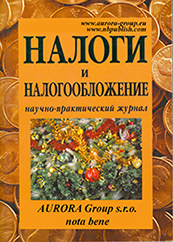PREDICTION AND PLANNING IN TAXATION
Reference:
Ermakov, D.N., Lipatova, I.V. (2014). Tax planning as management of economic processes at the micro-level. Taxes and Taxation, 7, 637Ц649. https://en.nbpublish.com/library_read_article.php?id=65298
Abstract:
The object of studies concerns the value of tax planning and management efficiency in economic
processes at the micro-level. The state offers business to use legally substantiated means minimizing
the tax base. It is a type of the compromise Ц an entrepreneur does not pay taxes while he complies with
the provisions of the Tax Code of the Russian Federation. The lawful means of lowering the tax burden
involve tax optimization. Organization of qualified work for calculating taxes shall also allow to lower
the unsubstantiated overpayment of taxes and to achieve good financial and economic markers. The
article discusses stages and principles of tax planning, much attention is paid to the efficiency of the
tax planning in an enterprise. Theoretical, methodological and empirical basis for the studies involved
fundamental theories and concepts of tax planning revealing theoretical and methodological fundamentals
of tax planning as developed by the Russian scientists. The scientific novelty of the article is due to
the generalization and systematization by the authors of the existing approaches to tax planning. The
authors analyzed the existing experience, offered the efficiency criteria for the tax planning, generalized
the positive practice of activities of the Russian organizations in the sphere of tax planning, the authors
offer criteria and algorithms for calculating efficiency of corporate tax planning.
Keywords:
methods of tax planning, principles of tax planning, tax planning, tax management, tax basis, taxation, interests of a tax-payer, interests of a state, tax benefits, management decisions.
PREDICTION AND PLANNING IN TAXATION
Reference:
Bogatyrev, S.Y. (2014). Tax aspects of business value assessment. Taxes and Taxation, 7, 650Ц661. https://en.nbpublish.com/library_read_article.php?id=65299
Abstract:
The Russian scientific school of value assessment does not provide sufficient studies of tax aspects
of business assessment. There is no detailed algorithm or practical recommendations for the assessor
with due consideration for the latest changes and novelties of the tax legislation at the level of
federal manuals. The article aims to fill this gap and define the main directions in the development of
manuals for assessment of tax aspects in cost assessment and analysis. The article provides definition
of tax law and legal responsibility when assessing business value, the author studies practical issues.
The author sets the goal of structuring the applied methods of assessment depending on various approaches
to assessment. The author establishes a dependency between business value and the measures
for tax restructuring, which are taken by the business owner or an investor buying an enterprise.
The author sets the directions for taking into account these factors, when defining investment cots.
The author postulates the directions for implementation of elements of tax law in the assessment:
holding tax audit, provisions for certain factual points of value for the tax consequences in the assessment
contract. The author singles out the directions for evaluation of the pre-sale structuring of the
assessed enterprise, defining the influence of the changes in the ownership of assets for optimizing tax
consequences within the framework of investment value. The author discusses the issues of defining
investment value of a business after the enterprise is restructured, as well as place and legal role of tax audit in assessment work. The author defines directions for tax inventory for business assessment,
establishing inventory points, property contents, tax risks, possibilities for implementation of certain
tax schemes, defects of an evaluated object, internal tax structure. The author offers to use the spread
of tax factors when defining investment cost and forming an assessment memo report. The author
casts light upon the issues of including taxes into the business value defined by an assessor offering
corrections of value depending on the structure in the business ownership in cases such as: remission
of taxes in cases of selling a business, selling participation in a business, purchase of a business in Russia
with loaned financing of a foreign buyer company, direct sale of assets Ц sale of business piece by
piece. Resolving the problems mentioned in this article shall assist the persons forming and using assessment
report in objective evaluation of value aspects in the process of gaining assessment results,
providing the state fiscal bodies with important analytical information for raising the tax base.
Keywords:
business value assessment, tax aspects of assessment, investment cost, tax audit, tax inventory, tax basis, tax factors, loaned financing, structure of business ownership, behavior factors.
FEDERAL TAXES AND LEVIES COLLECTED FROM ORGANIZATIONS
Reference:
Bazhenov, A.A. (2014). Value added tax: novelties in tax classification and metamorphoses of taxation elements. Taxes and Taxation, 7, 662Ц669. https://en.nbpublish.com/library_read_article.php?id=65300
Abstract:
The article concerns evaluation of analysis of a federal tax: Value Added Tax (VAT). It is established
that the tax classification based upon subject de facto bearing the tax burden provides division
of the latter into direct and indirect ones. However, taking into consideration the current mechanism
for tax calculation and sources of its payment, there is a possibility for a different classification. At the
same time this possibility is objectively proven and supported with the normative legal basis. It is also
shown that the constant development and improvement of the tax legislation in some cases leads to
the formation of the new problems, requiring taking measures in order to deal with these problems
including legislative amendments. One of such problems regarding VAT calculation is the conflict between
the tax basis and the object of taxation. The methodology of studies is based upon the dialectic
cognition method presupposing the studies of economic relations and matters in their development and
interrelation, methods of systemic and comparative analysis, economic mathematical studies of data,
synthesis, graphic modeling, methodology of statistical theory. In the process of analysis it is established
that specific features of VAT calculation within the framework of the current tax legislation provides for
a possibility to classify this tax as an indirect-direct one. At the same time the classic classification of
taxes (direct and indirect) should be evaluated critically. Additionally, the analysis of consistency of the
VAT taxation object and its tax basis shows the problem requiring a legislative solution. In order to deal
with the conflict between the tax basis and the object of taxation there is need to define the moment of
realization (sale), and not the moment of payment or shipment of goods, since it may also be the moment
of either shipping or payment (if this matter is directly provided for in the contract).
Keywords:
VAT, direct, indirect, burden, object of taxation, tax basis, shipment, payment, moment, obligation.
TAXATION OF NON-PROFIT ORGANIZATIONS
Reference:
Grischenko, A.V. (2014). Non-profit enterprises in the condition of tax system reform in the Russian Federation. Taxes and Taxation, 7, 670Ц675. https://en.nbpublish.com/library_read_article.php?id=65301
Abstract:
The article concerns history of development of non-profit enterprises in the Russian Federation.
The author provides analysis of organizational and legal specificities of their functioning. Analysis has shown that non-profit enterprises play an important social, economic and political role in the
society, providing services, being employers and human rights activists. They also play a less obvious
but nevertheless important role in the development of the civil society, facilitating improvement of
living standard, supporting and facilitating civil and religious values. The article provides a study of
the modern situation in the tax legislation, making tax statuses of commercial and non-profit organizations
basically equal. The author makes a conclusion on the need to develop a clear conceptual
approach towards formation of the system of legal and tax identity of non-profit organizations, which
has to be taken simultaneously with the improvement of the legislation on commercial enterprises.
When there is a united system of organizational legal forms, there shall be a possibility of provision
of tax preferences to the due subjects by the state. When choosing recipients of profits among the
non-profit organizations, attention should be paid to the types of activity of these organizations and
sources of their financing.
Keywords:
non-profit organizations, tax system, reform, tax policy, tax preferences, tax exemption, third sector of economy, public organizations, socially-oriented, foreign tax agent.
Tax administration
Reference:
Lomakina, E.V. (2014). Development of the institutional basis for the tax system of Russia for guaranteeing of the regulating
function of the tax policy. Taxes and Taxation, 7, 676Ц687. https://en.nbpublish.com/library_read_article.php?id=65302
Abstract:
The article provides analysis of the main types of tax policy depending on the phase of economic
cycle of its development. The author provides analysis of the normative legal guarantees of the
functions of the participants of regional tax policy in the sphere of public economy regulation based
upon the example of the Altai region. The author has studied the global scientific practices in the
sphere of state regulation and competence of the participants of the tax policy as an element of the
financial policy of the state. Topicality of this study is due to the existing problems regarding application
of the regulating function of the tax policy, its methodical introduction in the regions, analysis of
statistical and economic data and evaluation of alternative regulations. It is established that the maximum
positive effect from the application of the regulating function of the tax policy may be achieved,
when there is a mechanism of interaction of regulation blocks and the system of control over evaluation
of the regulating influence. The practical introduction of the provided regulating mechanism of
the tax policy may be taken via formation of the institution of independent audit assessment of the
regional tax policy within the framework of the tax reform in Russia.
Keywords:
tax, policy, subjects, tax legislation, economics, public regulation, control, taxation, tax system, tax competition.
THEORY AND HISTORY OF TAXATION
Reference:
Zholobova, G.A. (2014). Mechanism of legal regulation of the trade in alcohol drinks in the conditions of the fiscal wine monopoly:
on the issue of efficiency of the alcohol policy in Russia at the verge of XIX Ц XX centuries. Taxes and Taxation, 7, 688Ц708. https://en.nbpublish.com/library_read_article.php?id=65303
Abstract:
In the latest decade the discussion of the drafts of the state policy in the sphere of production
and turnover of the alcoholic drinks and formation of healthy lifestyle of the Russian population, there
is an active optimization process in the legislation in this sphere of social relations. Understanding the
historical nature of the Russian mechanism of legal regulation of trade in alcoholic drinks in late XIX Ц early XX centuries and the general experience of alcohol policy are important factors for the formation
of the modern concept of state regulation of the alcohol turnover in Russia. Since production and sale
of alcohol in the second half of XIX and early XX centuries was an important part of public income, the
government was interested in growing amount of the alcohol levy and it was worried by illegal production
and sale of alcohol causing the state to lose large profits. This matter required detailed regulation
of alcohol trade. On the other hand its regulation was also based upon the moral and medical
matters, since development of production and sale of alcohol was always closely connected with the
problem of alcoholism of the population. Based upon the analysis of the legislative acts of the Russian
Empire of late XIX Ц early XX centuries and the studies of the materials of the Ministry of Finances the
author presents the Russian retrospective of the mechanism for the legal regulation of trade in alcohol
drinks in the conditions of fiscal alcohol monopoly, showing the steps towards achieving the goals
of the state and analyzing its results.
Keywords:
law, Russian Empire, state, monopoly, alcoholic drinks, alcohol, trade, supervision, wine, beer, excise, vodka, spirit.
THEORY AND HISTORY OF TAXATION
Reference:
Frumina, S.V., Zhuravleva, T.A. Shapchits, L.A. (2014). Problems of innovation stimulation: a financial aspect. Taxes and Taxation, 7, 709Ц717. https://en.nbpublish.com/library_read_article.php?id=65304
Abstract:
The object of studies involves the combination of the applied methods of state regulation via
taxes and their structural elements, which are aimed at the stimulation of innovation developments
for the purpose of technological modernization of the Russian economy. The target elements of tax
stimulation include preferences and reductions. The ambiguousness of the interpretations of these
terms allows the tax bodies of the Russian Federation to demonstrate varying attitudes towards control
over the use of these instruments. The biased attitude of the Federal Tax Service of the Russian
Federation to the control over the use of reductions by the tax-payers makes the tax-payers avoid their
use. The study is based upon the document analysis and the combination of synthesis and systematizing.
With the use of the method of generalization of scientific and legislative approaches to the
Russian tax practice the authors define the specificities of application of the terms УpreferencesФ and
УreductionsФ. The authors provide theoretical generalizations, showing the goals and conditions for
the tax stimulation of innovative activities via preferences and reductions, showing the contradictions
in the official documents regarding identification of the terms УpreferenceФ and УreductionФ. The authors
then attempt to single out differences and to substantiate the need to provide for their definition
at the legislative level. It is shown that current Russian taxation system is not wholly oriented at the
improvement of innovative activities of economic subjects in the science-intensive spheres. The authors
provide arguments proving lack of methods for the efficiency evaluation for the tax preferences
and reduction, further complicating the formation of conclusion on the influence of the tax reductions
upon the innovative development of the Russian economy.
Keywords:
tax stimulation, innovations, financial policy, tax policy, reductions, preferences, efficiency, taxation, profit tax, tax basis.
 This work is licensed under a Creative Commons Attribution-NonCommercial 4.0 International License.
This work is licensed under a Creative Commons Attribution-NonCommercial 4.0 International License.
 Eng
Eng












 © 1998 Ц 2025 Nota Bene. Publishing Technologies. NB-Media Ltd.
© 1998 Ц 2025 Nota Bene. Publishing Technologies. NB-Media Ltd.




